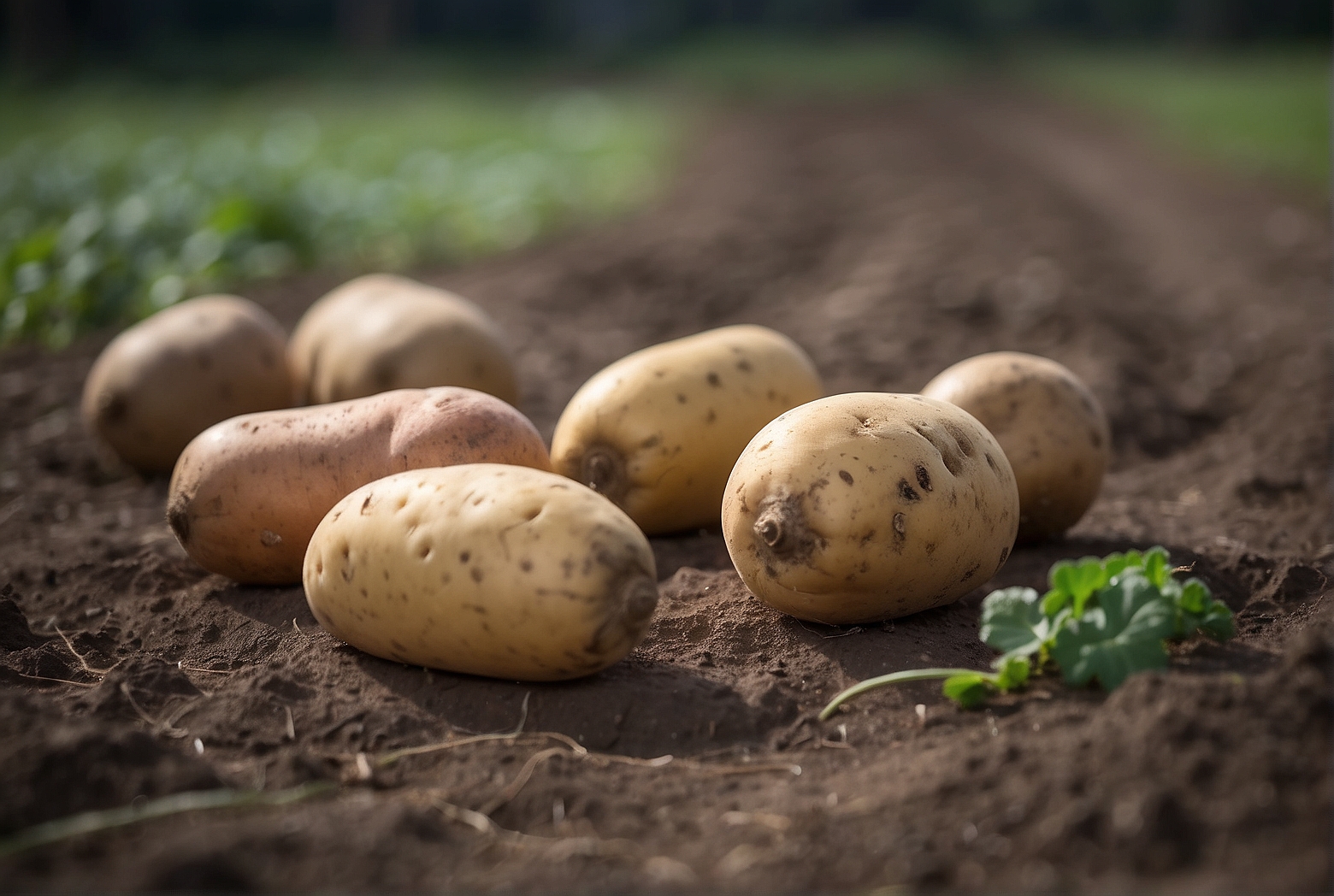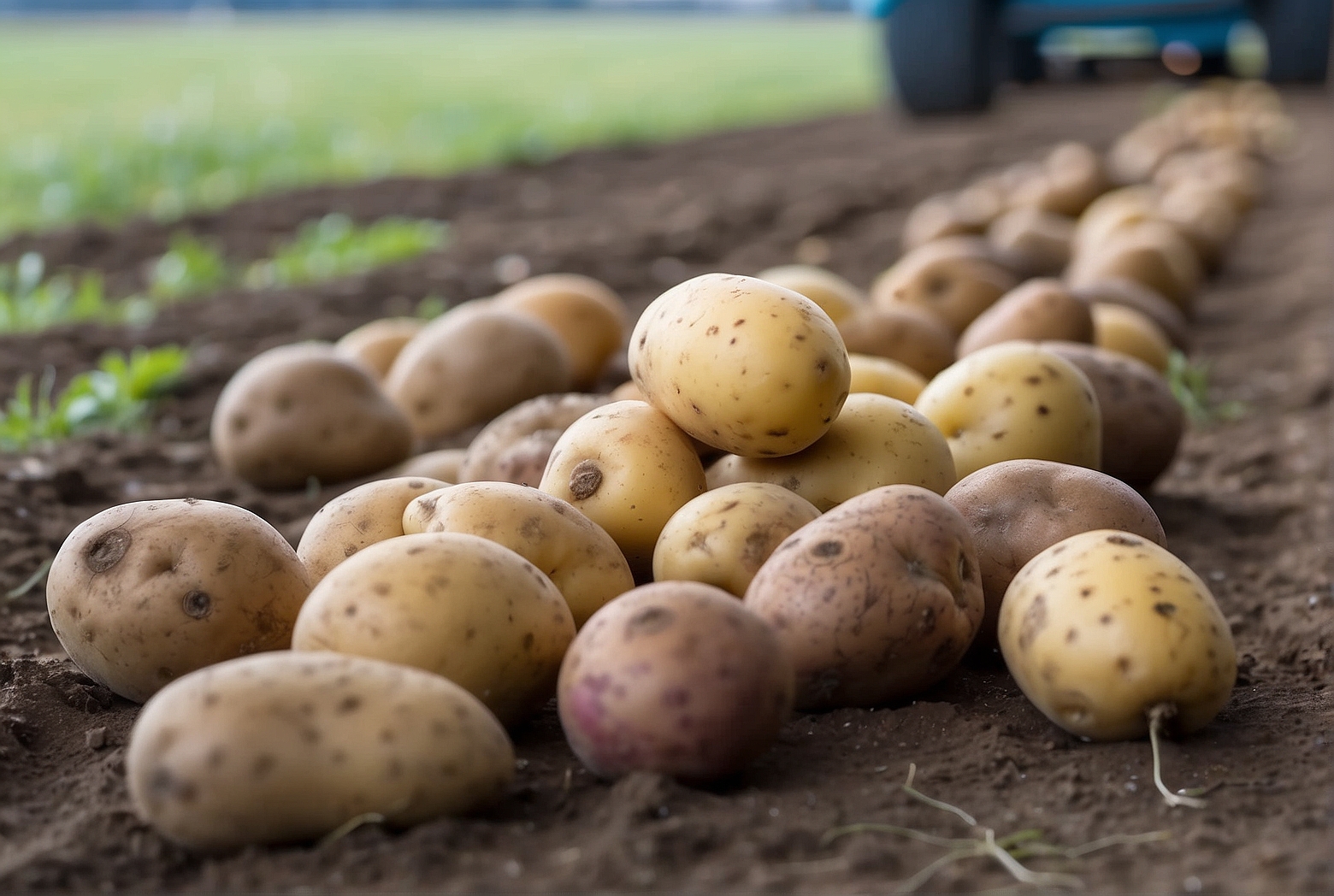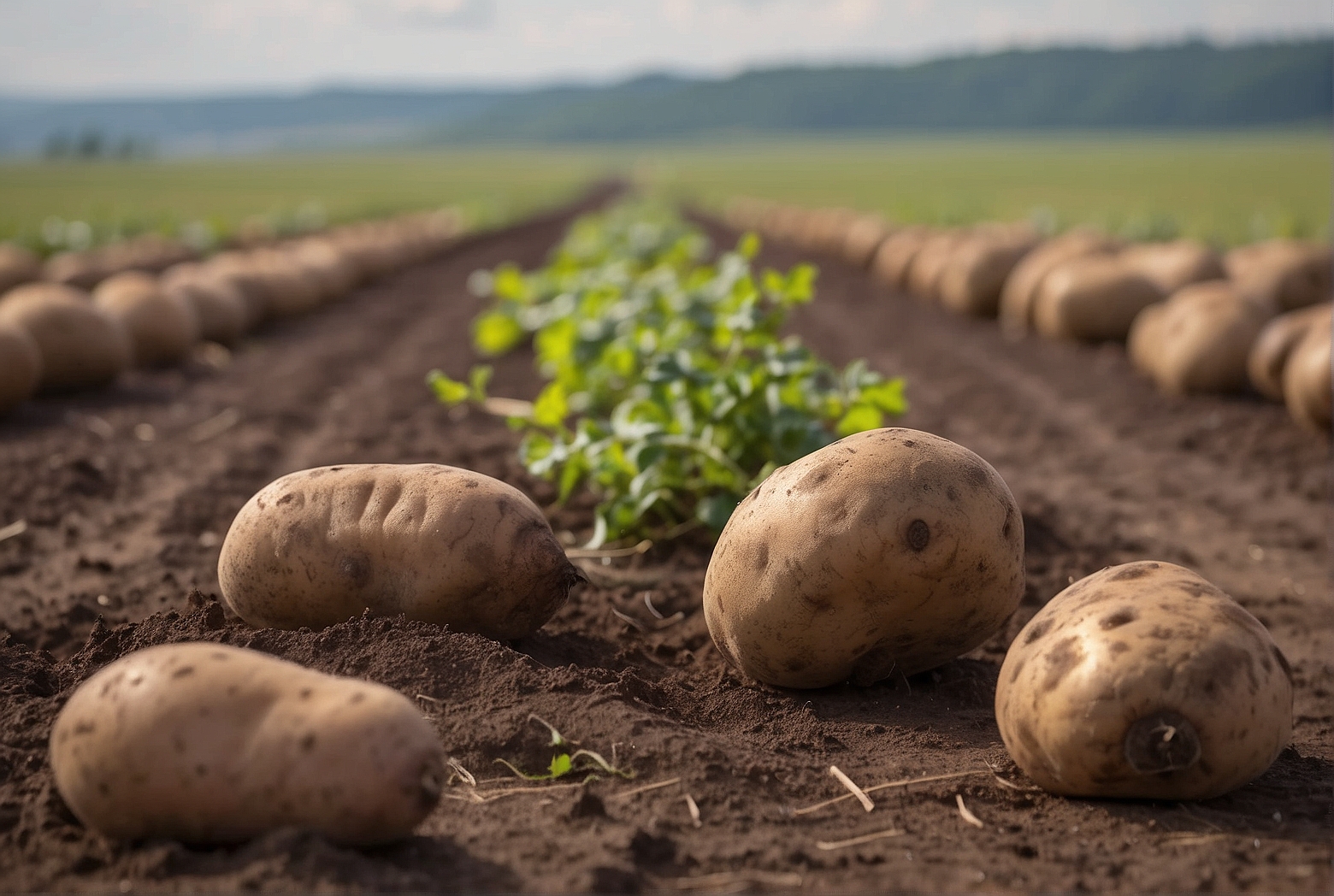Last Updated on March 29, 2024 by Tony Manhart
Imagine strolling down the produce aisle, contemplating which potatoes to add to your shopping cart. But wait, have you ever stopped to wonder about the distinction between determinate and indeterminate potatoes? Don’t fret, for this article aims to shed light on this fascinating topic. In a nutshell, determinate potatoes have a fixed growth pattern, resulting in a more compact plant, while indeterminate potatoes continue to grow and produce tubers throughout the growing season. So, get ready to uncover the secrets behind these potato variations and discover how they can influence your gardening experience.
Definition of Determinate and Indeterminate Potatoes
Determinate and indeterminate potatoes are two distinct types of potato plants that can be grown in your garden. The classification of these potatoes is based on their growth habits, plant structure, and fruiting time. Understanding the differences between determinate and indeterminate potatoes can help you choose the right type for your garden and maximize your potato harvest.
Determining Growth Habit
The growth habit of a potato plant refers to its overall size and structure. Determinate potatoes have a limited growth height, typically reaching a height of two to three feet. They have a compact and bushy structure, with shorter stems and more concentrated foliage. On the other hand, indeterminate potatoes have a tall growth height, often exceeding three feet. They have a spreading and vine-like structure, with longer and more sprawling stems.
Plant Structure
The difference in plant structure between determinate and indeterminate potatoes is closely related to their growth habit. Determinate potatoes have a more compact and dense foliage, with leaves closely packed together. Their stems are shorter and sturdier, providing better support for the developing potatoes. Indeterminate potatoes, on the other hand, have a more open and spreading foliage, with leaves spaced further apart. Their stems are longer and more flexible, allowing the plant to spread out as it grows.

Fruiting Time
The fruiting time of a potato plant refers to when it produces its potatoes. Determinate potatoes are early-maturing, meaning they produce their potatoes relatively quickly. They typically start forming potatoes around 60-70 days after planting. Indeterminate potatoes, on the other hand, are late-maturing, meaning they take a longer time to produce potatoes. They usually start forming potatoes around 80-100 days after planting.
Characteristics of Determinate Potatoes
Determinate potatoes have specific characteristics that set them apart from indeterminate potatoes. These characteristics make them an excellent choice for certain garden situations.
Limited Growth Height
The limited growth height of determinate potatoes makes them well-suited for smaller gardens or containers. Their compact structure allows you to maximize space and grow multiple plants in a confined area.
Compact and Bushy Structure
The compact and bushy structure of determinate potatoes makes them easier to manage and maintain. The concentrated foliage allows for better light penetration and improved air circulation, reducing the risk of diseases or pests.

Early Maturity
The early maturity of determinate potatoes means that you can enjoy an early harvest. They produce potatoes more quickly, allowing you to enjoy their delicious taste sooner than indeterminate potatoes.
Characteristics of Indeterminate Potatoes
Indeterminate potatoes also have distinct characteristics that make them a suitable choice for different garden situations. These characteristics contribute to their unique growth habits and harvesting requirements.
Tall Growth Height
The tall growth height of indeterminate potatoes makes them ideal for larger gardens or farms. Their sprawling vines can cover more ground, allowing for a higher potato yield.
Spreading and Vine-Like Structure
The spreading and vine-like structure of indeterminate potatoes require ample space for growth. They may need more room to avoid crowding and to ensure proper air circulation around the plant.
Late Maturity
Unlike determinate potatoes, indeterminate potatoes take a longer time to mature and produce potatoes. This means that you’ll have to wait a bit longer before you can harvest your potatoes. However, this longer growing season can result in a more extended potato harvest period, giving you a continuous supply.
Garden Considerations for Determinate Potatoes
When growing determinate potatoes in your garden, there are certain considerations to keep in mind to ensure their successful growth and harvest.
Space Requirement
Determinate potatoes have a limited growth height, but they still require adequate space for their development. Plant them in areas with enough room for their compact structure and for proper sunlight exposure.
Trellising and Support
While determinate potatoes are generally more compact, some varieties may benefit from trellising or support. This can help them stay upright and provide additional support for the developing potatoes.
Harvesting Process
The harvesting process for determinate potatoes is relatively straightforward. Since they mature and produce potatoes earlier, you can expect to harvest them sooner. When the plants start to yellow and die back, it’s a sign that they are ready for harvest. Gently dig around the plants to unearth the potatoes, being careful not to damage them.
Garden Considerations for Indeterminate Potatoes
Growing indeterminate potatoes requires careful planning and consideration due to their sprawling growth habits.
Space Requirement
Indeterminate potatoes need ample space for their sprawling vines to spread out. Plan your garden layout accordingly, ensuring that there is enough room for each plant to grow and receive adequate sunlight.
Managing Vigorous Growth
Indeterminate potatoes have a tendency for vigorous growth, which means they can quickly take over your garden if not managed properly. Regular pruning and training of the vines can help control their growth and prevent them from becoming tangled or overcrowded.
Devoting Time and Effort
Indeterminate potatoes require more time and effort compared to determinate potatoes. The longer growing season means you’ll need to be patient and dedicated in caring for and nurturing the plants until they are ready for harvest.
Advantages of Determinate Potatoes
Determinate potatoes offer several advantages that make them an attractive choice for gardeners with specific needs or limitations.
Easy to Manage
The compact and bushy structure of determinate potatoes makes them easier to manage and maintain. Their more contained growth habit requires less pruning and training, allowing for a more effortless gardening experience.
Ideal for Small Gardens or Containers
Determinate potatoes are well-suited for small gardens, balconies, or containers due to their limited growth height. If you have limited space but still want to enjoy the delight of growing potatoes at home, determinate varieties are an excellent choice.
Early Harvest
One of the significant advantages of determinate potatoes is their early maturity. The shorter time it takes for them to produce potatoes means an early harvest, allowing you to enjoy their delicious flavor sooner.
Advantages of Indeterminate Potatoes
Indeterminate potatoes offer unique advantages that make them a favored choice for larger gardens or farms.
Higher Yield Potential
The tall growth and sprawling vines of indeterminate potatoes result in a higher yield potential. With proper care and management, you can harvest more potatoes from each plant, maximizing your overall harvest.
Extended Harvest Period
While indeterminate potatoes take longer to mature, they provide an extended harvest period. This means you can enjoy a continuous supply of fresh potatoes over a more extended period, allowing for more flexibility in your meal planning.
Suitable for Larger Gardens or Farms
Indeterminate potatoes thrive in larger gardens or farm settings. Their sprawling growth habit requires more space, which can be accommodated in larger outdoor areas. If you have ample land available, indeterminate varieties can provide you with a bountiful potato harvest.
Disadvantages of Determinate Potatoes
Despite their advantages, determinate potatoes have a few disadvantages that should be considered before deciding to grow them.
Limited Potato Production
Due to their limited growth height and compact structure, determinate potatoes tend to produce a smaller quantity of potatoes compared to indeterminate varieties. If you’re looking for a substantial potato harvest, indeterminate potatoes may be a better option.
Less Storage Time
Determinate potatoes typically have a shorter storage time compared to indeterminate potatoes. Their early maturity means that they may not store well for extended periods. It’s best to consume or preserve them as soon as possible to prevent spoilage.
Susceptible to Environmental Factors
Determinate potatoes are more susceptible to environmental factors such as heat or drought. Their limited growth height and concentrated foliage make them more sensitive to changes in temperature and moisture levels. Adequate care and attention should be given to ensure their survival and productivity.
Disadvantages of Indeterminate Potatoes
While indeterminate potatoes have their advantages, there are also a few disadvantages to consider before growing them.
Requires More Space
The sprawling growth habit of indeterminate potatoes requires more space compared to determinate potatoes. If you have a small garden or limited area available, growing indeterminate varieties may pose challenges in terms of space management.
Prone to Diseases and Pests
The open and spreading foliage of indeterminate potatoes can make them more susceptible to diseases and pests. The increased surface area and dense foliage create favorable conditions for pests and diseases to thrive. Regular monitoring and preventive measures are essential to keep your plants healthy.
Longer Growing Season
Indeterminate potatoes have a longer growing season compared to determinate potatoes. This means it will take more time for them to mature and produce potatoes. If you’re looking for a quick harvest, indeterminate varieties may not be the best choice.
Choosing the Right Potato Type for Your Garden
When deciding on the right type of potato for your garden, several factors should be taken into account.
Consider Available Space
Evaluate the space you have available in your garden and choose a potato variety that fits your garden’s size. If you have limited space, determinate potatoes are a better choice, while indeterminate potatoes are suitable for larger gardens or farms.
Evaluate Time and Effort
Consider the amount of time and effort you are willing to invest in growing potatoes. If you prefer a low-maintenance option that yields an early harvest, determinate potatoes are a great choice. However, if you have the patience and dedication to care for indeterminate potatoes with the reward of a higher yield over a longer period, they may be the better choice for you.
Assess Storage and Usage Needs
Think about how you plan to use your harvested potatoes. If you prefer to store them for an extended period or have specific storage requirements, such as preserving or canning, indeterminate potatoes are better suited for these needs. Determinate potatoes are best enjoyed fresh and may not store well for extended periods.
By considering these factors, you can make an informed decision and select the right type of potato that suits your garden’s needs and your preferences as a gardener.
Tony Manhart is a passionate gardener who has been tending to gardens for over 20 years. He takes pride in creating beautiful outdoor spaces with plants, trees, and shrubs that can thrive in any environment. He loves to share his knowledge with others and has taught classes on gardening basics and advanced techniques. He is committed to sustainability, using natural and organic methods to create and maintain gardens. He also works with local organizations to create green spaces for communities. When he’s not gardening, Tony enjoys hiking, reading, and spending time with his family.


